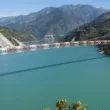In the heart of the majestic Himalayas lies an engineering marvel that stands as a testament to human ingenuity and determination — the Tehri Dam. As we delve into the intricacies of this architectural wonder, we are bound to be captivated by the sheer scale and brilliance behind its creation.
A Glimpse into Tehri Dam’s History
The Tehri Dam, situated on the Bhagirathi River in Uttarakhand, India, has a rich history dating back to its conception in the mid-20th century. Initiated with the primary objectives of hydroelectric power generation and water resource management, the dam has evolved into a multifaceted structure with far-reaching implications for the region.
Unraveling the Architectural Marvel
1. Structural Brilliance
At its core, Tehri Dam is an imposing structure, towering over the landscape with a height that commands attention. The dam’s design intricacies involve a combination of rock and earth-fill, creating a robust foundation capable of withstanding the immense pressure exerted by the reservoir.
2. Hydroelectric Power Generation
One of the pivotal features of Tehri Dam is its role in harnessing the power of the Bhagirathi River for electricity generation. The dam boasts a state-of-the-art hydroelectric power plant that has significantly contributed to India’s energy grid, providing sustainable and clean electricity to millions.
Environmental Impact and Conservation Efforts
3. Reservoir and Biodiversity
The creation of the Tehri Dam reservoir has not been without its environmental implications. However, stringent measures have been implemented to mitigate the impact on local ecosystems. Efforts to preserve and enhance biodiversity in the surrounding areas showcase a commitment to environmental sustainability.
4. Community Engagement and Development
Beyond its structural and energy-related contributions, Tehri Dam has played a pivotal role in community development. The project has spurred economic growth in the region, providing employment opportunities and fostering infrastructural advancements that benefit local residents.
Challenges Overcome
5. Geological Challenges
The Himalayan region presents unique geological challenges, and the construction of Tehri Dam was no exception. Engineers and experts had to navigate through rugged terrain, seismic considerations, and the geological intricacies of the region, demonstrating unparalleled problem-solving skills.
6. Socio-Political Landscape
Tehri Dam’s journey from inception to completion traversed a complex socio-political landscape. Overcoming bureaucratic hurdles and addressing concerns of local communities required a delicate balance of diplomacy and project management acumen.
Conclusion
In conclusion, Tehri Dam stands not only as a marvel of engineering but as a symbol of human determination in the face of challenges. From its humble beginnings to its current status as a powerhouse of energy and development, Tehri Dam’s journey is nothing short of extraordinary.
Similar Articles
Frequently Asked Questions (FAQs) About Tehri Dam
What is Tehri Dam?
Tehri Dam is a monumental structure situated on the Bhagirathi River in Uttarakhand, India. It is one of the largest dams in the world, designed to harness the river’s power for hydroelectricity generation and manage water resources in the region.
How tall is Tehri Dam?
Tehri Dam stands at an impressive height, reaching approximately 260.5 meters (855 feet). Its towering presence is a testament to the engineering prowess behind its construction.
What is the primary purpose of Tehri Dam?
The primary objectives of Tehri Dam include:
- Hydroelectric Power Generation: The dam houses a state-of-the-art hydroelectric power plant, contributing significantly to India’s energy grid.
- Water Resource Management: Tehri Dam plays a crucial role in managing water resources in the region, providing irrigation and drinking water to nearby areas.
How does Tehri Dam contribute to electricity generation?
Tehri Dam harnesses the potential energy of the Bhagirathi River to generate electricity. The dam’s hydroelectric power plant converts the flowing water’s energy into electrical power, contributing substantially to India’s renewable energy capacity.
What environmental impact does Tehri Dam have?
While the construction of Tehri Dam has led to the creation of a reservoir, it has also raised environmental concerns. Efforts, however, have been made to minimize the impact on biodiversity. Conservation initiatives and environmental management strategies are in place to ensure sustainable coexistence.
How has Tehri Dam impacted local communities?
Tehri Dam has had a positive impact on local communities, contributing to:
- Economic Growth: The dam project has stimulated economic growth, creating employment opportunities and boosting local businesses.
- Infrastructure Development: The region has witnessed infrastructural advancements, improving the overall quality of life for residents.
Were there any challenges faced during Tehri Dam’s construction?
The construction of Tehri Dam encountered various challenges, including:
- Geological Challenges: Negotiating the unique geological characteristics of the Himalayan region requires innovative engineering solutions.
- Socio-Political Complexities: Overcoming bureaucratic hurdles and addressing the concerns of local communities demanded a nuanced approach.
Is Tehri Dam safe in seismic-prone areas?
Given its location in a seismic-prone region, Tehri Dam has been designed with robust seismic considerations. Engineers have implemented advanced technologies and construction techniques to ensure the dam’s safety and stability during seismic events.
How can one visit Tehri Dam?
Tehri Dam is accessible to visitors, and guided tours are often available. The dam’s location amidst the picturesque Himalayan landscape makes it a compelling destination for those interested in witnessing the convergence of engineering and nature.
In Conclusion
Tehri Dam stands not only as an architectural marvel but also as a symbol of sustainable development. Through addressing FAQs, we aim to provide comprehensive insights into the dam’s significance, functionality, and impact on both the environment and local communities.









